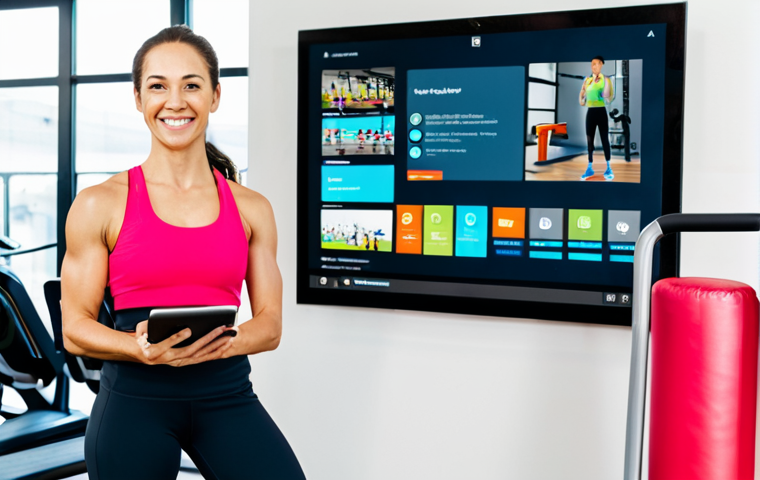I’ve seen it firsthand, and maybe you have too: the relentless hustle of a personal trainer. Early mornings, late nights, constantly chasing new clients, all while trying to stay ahead of the curve.
It’s an exhausting cycle, isn’t it? I remember thinking, ‘Is this passion truly sustainable?’ Many of us enter this field with boundless energy, only to find our flame flickering as client churn becomes a recurring nightmare and the competition heats up.
The fitness landscape is morphing at an incredible pace. We’re seeing a massive shift towards holistic wellness, hyper-personalized training powered by AI-driven insights, and the undeniable rise of digital coaching platforms.
The days of simply showing up at the gym are rapidly evolving. To truly thrive, not just survive, in this dynamic environment, we need to talk about something crucial: sustainable management for personal trainers.
It’s no longer just about getting clients; it’s about building a resilient, adaptable business model that ensures your longevity and keeps your passion alive for years to come.
This isn’t just a trend; it’s the future. Let’s dive deeper in the article below.
Beyond the One-on-One: Diversifying Your Revenue Streams

For so long, the personal training world has been synonymous with the hourly grind – one client, one session, one payment. And don’t get me wrong, that direct, personalized connection is at the heart of what we do and why we love it. But relying solely on that model? It’s like trying to build a skyscraper with just one type of brick. I remember feeling that intense pressure, constantly trying to fill my schedule, dreading cancellations. It’s a constant chase that can quickly lead to burnout if you’re not careful. To truly build a resilient and thriving business, we need to think beyond the immediate transaction and explore multiple avenues for income. This isn’t just about making more money; it’s about creating financial stability and freeing up your time, allowing you to focus on delivering even better results for your clients.
1. Expanding into Group Coaching and Workshops
One of the first shifts I made was embracing group dynamics. Think about it: instead of training one person, you can train five, ten, or even twenty at once, leveraging your time much more efficiently. This doesn’t dilute the quality; it simply changes the delivery mechanism. I’ve found that group workshops on topics like “Beginner’s Guide to Weightlifting” or “Nutrition for Busy Professionals” are incredibly popular. People love the camaraderie, the shared motivation, and often, the more accessible price point. It also allows you to reach a wider audience who might not be ready for one-on-one but are curious about what you offer. These can be in-person or, increasingly, virtual, opening up your geographical reach significantly. Starting small with a few trusted clients or a specific niche can help you iron out the kinks and build confidence before scaling up.
2. Leveraging Digital Products and Online Programs
This is where the real game-changer comes in, especially for sustainable growth. Imagine creating a workout plan, a nutrition guide, or a series of educational videos once, and selling it countless times. That’s the power of digital products. I vividly recall the satisfaction of waking up to a sale notification for an e-book I’d created months ago – passive income at its best! Whether it’s a downloadable PDF of custom meal plans, a pre-recorded online course on mastering bodyweight exercises, or a subscription-based platform offering exclusive content, digital offerings allow you to decouple your income from your time. It takes upfront effort, yes, but the long-term rewards in terms of flexibility and scalability are immense. This also builds your authority and expertise, positioning you as a go-to resource in your niche.
Building an Unshakeable Online Presence: Your Digital Empire
In today’s interconnected world, if you’re not visible online, you’re practically invisible. I’ve heard countless trainers say, “My clients come from referrals,” and while that’s wonderful, it’s often not enough to sustain consistent growth in the long run. I remember hesitating to really dive into social media, thinking it was just for “influencers.” But what I quickly realized is that your online presence isn’t just about chasing likes; it’s about building trust, demonstrating your expertise, and making it easy for potential clients to find you. It’s your digital storefront, your virtual handshake, and your loudest megaphone all rolled into one. Your professional identity online needs to clearly communicate your unique value proposition and connect with your target audience on a deeper level than just showcasing impressive squats.
1. Crafting a Compelling Brand and Niche
Before you even think about posting, you need to define who you are as a trainer and who you serve. Trying to appeal to everyone means appealing to no one. I learned this the hard way trying to be a “generalist” and found myself constantly chasing after leads that weren’t a good fit. Once I honed in on my niche – let’s say, busy professionals seeking sustainable fitness habits – everything clicked. Your brand isn’t just your logo; it’s your voice, your values, and the unique experience you offer. When you know your ideal client, you can speak directly to their pain points, their goals, and their aspirations, creating an immediate and powerful connection. This clarity will guide all your online content and attract the right people to your services.
2. Leveraging Content Marketing Across Platforms
Content is king, and consistency is queen. This means regularly sharing valuable, informative, and engaging content across platforms where your ideal clients hang out. This could be short-form videos on TikTok or Instagram Reels showcasing proper form, longer educational videos on YouTube dissecting common fitness myths, or detailed blog posts on your website offering in-depth guides. I personally found immense success through blogging, as it allowed me to delve deep into topics and establish myself as a thought leader, which then drove traffic directly to my services. The key is to provide value without always asking for something in return. Answer questions, offer tips, share success stories – essentially, become a trusted resource that people look to for guidance, naturally drawing them into your ecosystem.
The Unsung Hero: Mastering Client Retention and Lifetime Value
Acquiring new clients is exhilarating, isn’t it? That initial rush of a new sign-up always felt like a victory to me. But here’s the thing I truly believe in now: retaining clients is far more crucial for long-term success than constantly chasing new ones. Think about it – it costs significantly more time, money, and energy to attract a new client than to keep an existing one happy and engaged. When a client stays with you for months, or even years, their lifetime value to your business skyrockets. They become your biggest advocates, referring friends and family, and essentially building your reputation for you. I remember getting so focused on filling my pipeline that I sometimes took my existing clients for granted. That was a huge mistake. Nurturing those relationships is the bedrock of a truly sustainable personal training business.
1. Personalization Beyond the Workout
True personalization goes beyond just writing a custom workout plan. It’s about understanding your client as a whole person, their life, their challenges, their non-fitness goals. I make it a point to check in with my clients even on their non-training days, a quick text asking how they’re feeling, celebrating a small victory outside the gym, or offering a word of encouragement. I’ve found that remembering details about their family, their job, or their hobbies makes them feel genuinely seen and valued. This builds a deeper connection that transcends the transactional nature of a training session. When clients feel cared for and understood, they are much more likely to stick around, even when life gets hectic or motivation wanes. It’s about building a relationship, not just providing a service.
2. Implementing Feedback Loops and Progress Tracking
How do you know if your clients are truly happy and progressing? You ask them! Regularly soliciting feedback, both formal and informal, is absolutely critical. I use short surveys every few months and also dedicate a few minutes at the end of sessions just to chat about what’s working, what’s not, and how they feel about their progress. Equally important is effective progress tracking. Clients want to see tangible results and feel like they’re moving forward. This could be regular measurements, strength tests, photos, or simply celebrating non-scale victories like better sleep or increased energy. When clients can clearly see their journey and feel like an active participant in their own success, their motivation and loyalty remain high. Transparency and tangible progress breed trust.
Smart Business, Smart Growth: Leveraging Technology and Automation
When I first started out, I was manually scheduling clients, tracking payments in a spreadsheet, and sending out reminder texts one by one. It was a chaotic mess, and I quickly realized how much precious time it was eating up – time I could have spent training, learning, or simply relaxing. Technology isn’t just a fancy add-on for a personal training business; it’s an absolute necessity for efficiency and scalability. It allows you to automate repetitive tasks, streamline operations, and ultimately, deliver a more professional and seamless experience for your clients. Embracing the right tools can feel daunting at first, but the long-term benefits in terms of time saved and reduced stress are immeasurable. It’s about working smarter, not just harder, and letting technology handle the grunt work so you can focus on what you do best: transforming lives.
1. Streamlining Operations with Client Management Software
If there’s one investment I recommend every personal trainer make, it’s in a robust client management system. This isn’t just about scheduling; it’s a comprehensive platform for everything from booking and payment processing to client communication, program delivery, and progress tracking. I remember the relief when I finally integrated a system that allowed clients to book and pay online without me lifting a finger. It drastically reduced no-shows and administrative headaches. These platforms can send automated reminders, store client profiles and waivers, and even host your workout programs, creating a centralized hub for your entire business. This level of organization not only saves you countless hours but also presents a highly professional image to your clients, making their experience smooth and effortless.
2. Automating Communication and Marketing
Imagine sending personalized birthday wishes to every client, or a follow-up email after their first session, all without you having to remember to do it manually. That’s the power of automation in communication. Email marketing platforms, for example, can be set up to deliver welcome sequences for new leads, send weekly newsletters with valuable tips, or even re-engage inactive clients with special offers. I’ve found that automated drip campaigns, tailored to specific client segments, can be incredibly effective in nurturing leads and building loyalty. This isn’t about being impersonal; it’s about being consistently present and valuable in your clients’ inboxes, without having to write every single email from scratch. This allows you to maintain consistent engagement and keep your services top-of-mind.
| Aspect | Traditional Personal Training | Sustainable & Diversified Personal Training |
|---|---|---|
| Revenue Model | Primarily 1-on-1 hourly sessions | Mix of 1-on-1, small groups, digital products, online courses |
| Time Management | Trading time directly for money; high risk of burnout | Leverages technology, automation, and scalable offerings; more flexible |
| Client Acquisition | Heavily reliant on referrals, word-of-mouth | Multi-channel approach: strong online presence, content marketing, targeted ads |
| Client Retention | Often reactive, focus on immediate session satisfaction | Proactive relationship building, personalized support, consistent feedback loops |
| Scalability | Limited by available hours in a day | High potential for growth through digital assets and diversified services |
| Risk Management | Vulnerable to client churn, market fluctuations | Multiple income streams provide stability and resilience |
Protecting Your Most Valuable Asset: Sustaining Your Well-being
Let’s be brutally honest for a moment: how many personal trainers do you know who are truly thriving, not just professionally, but personally? The fitness industry, ironically, can be incredibly demanding on our own health and well-being. Early mornings, late nights, constant physical exertion, and the emotional labor of motivating others – it all adds up. I’ve been there, running on fumes, feeling the creeping sense of resentment as my own training and personal life took a backseat. It was a harsh realization that if I wasn’t taking care of myself, I couldn’t possibly give my best to my clients. Sustainable management isn’t just about your business; it’s fundamentally about you. You are the engine, and if the engine breaks down, the whole vehicle grinds to a halt. Prioritizing your own well-being isn’t selfish; it’s a strategic business decision.
1. Setting Healthy Boundaries and Work-Life Balance
This is often easier said than done, especially when you’re passionate about what you do. But without clear boundaries, your personal life will inevitably bleed into your professional one, leading to exhaustion. I had to learn to say “no” – no to late-night sessions that compromised my sleep, no to weekend appointments that ate into family time, and no to constant availability. Establishing set working hours, scheduling breaks, and even designating “unplugged” periods are crucial. Communicating these boundaries clearly to your clients from the outset helps manage expectations. Remember, you’re a professional, not a 24/7 emergency service. By honoring your personal time, you come back to your work refreshed, energized, and more effective for your clients. This is a non-negotiable for long-term success.
2. Prioritizing Your Own Fitness and Recovery
It sounds obvious, right? We’re personal trainers, we’re supposed to be fit! Yet, so many of us neglect our own training and recovery because we’re so busy focusing on others. I can tell you from personal experience that showing up for clients feeling tired, sore, or unmotivated is a recipe for disaster. Your energy is contagious, and if you’re not fueled, neither will your clients be. Schedule your own workouts and recovery time (mobility work, stretching, rest days) with the same discipline you apply to your client sessions. It’s not just about maintaining your physical health; it’s about role-modeling the very lifestyle you preach. Clients look to you as an example, and maintaining your own peak performance underscores your credibility and commitment. Plus, it’s vital for your mental resilience against the daily pressures of the job.
The Future-Proof Trainer: Adapting to Market Shifts and Emerging Trends
The fitness industry is a dynamic beast, constantly evolving. What was cutting-edge yesterday might be obsolete tomorrow. I’ve witnessed countless trends come and go, from specific diets to workout methodologies, and I’ve seen trainers who refused to adapt slowly fade away. The reality is, standing still in this profession means falling behind. To ensure your longevity and continued relevance, you need to cultivate a mindset of continuous learning and proactive adaptation. This isn’t about chasing every fleeting fad, but rather understanding the underlying currents shaping the industry and strategically positioning yourself to meet future client needs. The ability to pivot and innovate will be your superpower in an ever-changing landscape.
1. Embracing Continuous Learning and Specialization
Never stop learning. Seriously. Whether it’s advanced certifications in niche areas like pre/post-natal fitness, corrective exercise, or sport-specific training, or simply staying abreast of the latest research in nutrition and exercise science, continuous education is non-negotiable. I make it a point to dedicate a certain number of hours each week to reading scientific journals, attending webinars, or listening to industry podcasts. Specializing allows you to carve out a unique position in the market, attract a very specific clientele, and become an undisputed expert in that field, leading to higher demand and pricing power. When you commit to lifelong learning, you not only elevate your expertise but also keep your passion ignited by constantly discovering new facets of your profession.
2. Anticipating Client Needs and Market Demands
Think beyond what clients are asking for today and try to anticipate what they’ll need tomorrow. Are people increasingly interested in holistic wellness beyond just physical fitness? Is wearable technology changing how clients track progress and expect feedback? Are virtual reality fitness experiences becoming more mainstream? Keeping an ear to the ground, observing societal shifts, and understanding demographic changes can help you innovate your services. For example, recognizing the rise of remote work might prompt you to develop more home-based workout programs or digital accountability solutions. By being proactive rather than reactive, you can position yourself as a forward-thinking leader, always one step ahead in meeting the evolving demands of the fitness market.
Closing Thoughts
Stepping back and reimagining your personal training business as a truly sustainable, resilient enterprise is one of the most empowering decisions you can make. It’s about building a legacy, not just a schedule. I truly believe that by diversifying your income, building a robust online presence, mastering client retention, leveraging technology, and critically, protecting your own well-being, you’re not just surviving in this industry – you’re set to truly thrive. This journey might feel challenging at times, but the freedom and fulfillment that come with a business designed for longevity are absolutely worth every strategic step.
Useful Information to Know
1. Explore Niche-Specific Software: While general CRMs are great, consider platforms tailored to fitness (e.g., Trainerize, Mindbody) that offer integrated program delivery, booking, and payment, saving you countless hours.
2. Start Small with Digital Products: Don’t feel overwhelmed; begin by converting your most requested workout or nutrition tip into a simple PDF guide or a short video series. You can always expand later.
3. Networking is Still King: Even with a strong online presence, connecting with other health professionals, physical therapists, and local businesses can provide invaluable referral streams and collaboration opportunities.
4. Invest in Professional Development Annually: Set aside a budget and time each year for new certifications, workshops, or industry conferences. This keeps your skills sharp and your expertise current.
5. Automate Your Social Media Scheduling: Use tools like Buffer or Hootsuite to pre-schedule your content. This ensures consistency without requiring you to be glued to your phone daily, freeing up your time.
Key Takeaways
Building a sustainable personal training business moves beyond hourly sessions to embrace diversified revenue streams, a strong digital presence, and proactive client retention. Leveraging technology for efficiency and prioritizing your personal well-being are crucial for long-term success. Continuously learning and adapting to market trends ensures your relevance and growth in an ever-evolving industry, empowering you to thrive for years to come.
Frequently Asked Questions (FAQ) 📖
Q: Given the “exhausting cycle” you mentioned, what do you see as the single biggest drain on a personal trainer’s passion and energy today?
A: Oh, that’s easy, and I’ve felt it deep in my bones: it’s the relentless grind of client acquisition and, more painfully, client churn. We get into this field because we genuinely want to help people transform, right?
But then you’re constantly on the hunt, marketing yourself, delivering session after session, only for some clients to drop off just as you’re starting to build momentum.
It’s like pouring your heart and soul into building a sandcastle, only for the tide to regularly wash away your progress. That instability, the constant financial anxiety of an empty slot in your calendar, that’s what truly wears you down.
It makes you question if you can keep showing up with that same boundless energy you started with, especially when you see competitors popping up everywhere.
Q: The article hints at significant shifts like “holistic wellness” and “
A: I-driven insights.” How realistic is it for a busy, often solitary personal trainer to genuinely adapt to these rapidly changing trends? A2: It’s incredibly realistic, and frankly, it’s not an option if you want to stay in the game for the long haul.
I know it feels like a lot when you’re already juggling sessions and life, but think of it this way: these aren’t just fads. Holistic wellness? People aren’t just looking for a six-pack anymore; they want better sleep, less stress, and more energy to live their lives fully.
If you’re not addressing that broader picture, you’re missing a huge part of the puzzle. As for AI, look, it’s not replacing us. It’s a tool!
Imagine having AI sift through data to give you hyper-personalized insights for your clients, freeing you up to focus on the human connection, the motivation, the actual coaching.
It’s about leveraging these tools to work smarter, not just harder. My own experience has shown me that embracing a few key tech solutions or expanding my knowledge beyond just exercise science has totally transformed how I operate, and honestly, made me a better coach.
Q: You talk about “sustainable management” as the future. What’s the practical difference between how trainers typically operate now and what this “resilient, adaptable business model” actually looks like?
A: The practical difference is moving away from the hamster wheel of trading hours for dollars, one client at a time. The traditional model is inherently fragile: if you’re sick, or a client cancels, your income takes a direct hit.
A resilient model, on the other hand, means diversifying your income streams and building leverage. Instead of just one-on-one sessions, think about creating online group programs that can serve 10 or 20 people at once.
Maybe you develop a specialized niche workshop you can offer quarterly, or even an evergreen digital product like a nutrition guide or a home workout plan.
The goal is to build assets that generate revenue even when you’re not actively coaching, giving you the financial breathing room to not burn out. I’ve seen countless trainers, myself included, shift from relying solely on hourly sessions to having multiple income pillars.
It’s about designing a business that supports your life and passion, not one that consumes it.
📚 References
Wikipedia Encyclopedia
구글 검색 결과
구글 검색 결과
구글 검색 결과
구글 검색 결과
구글 검색 결과






